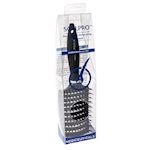-
ANDROGENETIC ALOPECIA: HAIR LOSS AND BALDNESS DUE TO A HEREDITARY CAUSE
Are you a man and are you losing more and more hair from the front and sides of your head? Are there even some bald spots starting to appear? Or do you, as a woman, suffer from thinning hair on the middle of your head? Then there is a good chance that you suffer from androgenetic alopecia. Especially if your parents or other family members also suffer from excessive hair loss, there is a good chance that you are genetically affected. In that case, hair loss is inevitable. That is very annoying because unwanted baldness and thinning hair can have a negative effect on your self-confidence.
Fortunately, there are ways to improve hair quality. You can read more about this later in this blog. But first let's take a look at what exactly androgenetic alopecia is, what it looks like and what the causes are.
-
WHAT IS ANDORGENETIC ALOPECIA?
Androgenetic alopecia is a form of hereditary hair loss and baldness that mainly affects men. It is estimated that around 70% of men will experience hair loss at some point in their lives. Most men are over 50, but some men already suffer from it when they are only in their 20s.
Androgenetic alopecia is much less common in women, but estimates are still around 40%. Hair loss usually begins in women around menopause, but it can also occur earlier.
WHAT DOES ANDROGENETIC ALOPECIA LOOK LIKE?
The course of androgenetic alopecia differs in men and women. With men, hair loss starts at the front of the head. A receding hairline is created, the characteristic V-shape. Afterwards, the hair at the temples also becomes thinner and you lose more and more hair around the crown. It is a gradual process that can continue until bald spots appear on the front, sides, and on top of the head. These bald spots can meet at some point, leaving only a fringe of hair on the back of the head and above the ears.
With women, hair loss mainly causes hair thinning. The hair loss is more even and mainly affects the hair on the middle of the head. Women do not get real bald spots there, but the scalp can be seen through the hair. The front of the hair does not become thinner in women, so the hair boundaries remain intact. Something that is not the case with men.
WHAT CAUSES ANDROGENETIC ALOPECIA?
Genetic predisposition plays a major role in androgenetic alopecia. It is hereditary whether you will suffer from it. The culprit in both men and women is a hereditary hypersensitivity of the hair follicles to dihydrotestosterone (DHT). The degree of hypersensitivity to DHT differs between men and women. The hypersensitivity is also not evenly distributed throughout the hair. Hence the differences in hair loss between men and women. Therefore, hair loss patterns can also differ from person to person.
Hypersensitivity to DHT has the following consequences for the hair:
The anagen phase is shorter
The anagen phase is the growth phase of the hair. About 66-96% of the hairs on the head are in this phase. How long the phase lasts varies per person. With women, the phase usually lasts a little longer. Is the anagen phase shorter than actually necessary? Then the hair implant appears thinner and therefore there is thinning hair.
The number of hairs in the telogen phase increases
The telogen phase is the phase in which hair falls out. About 2-18% of all hairs are in this phase. If more hairs than normal fall out, this is excessive hair loss. To compensate for this, more hair than normal must grow back. If this is not done, bald spots may appear after a while.
The hair follicle shrinks
Over time, hypersensitivity to DHT causes the hair follices to shrink. Shrinked hair follicles are no longer usable, making new hair growth no longer possible. This disrupts the natural growth cycle of the hair. Add to this the fact that more hair than normal is already falling out, and it is clear why baldness is ultimately the result.
Androgenetic alopecia always develops gradually. Even though it is already determined in the genes at birth whether someone will suffer from it. With each hair cycle, the hair becomes thinner and fewer hairs grow back. Environmental factors can slow down the process but also speed it up. For example, excessive stress, an unhealthy lifestyle, and vitamin deficiency are always culprits when we look at possible causes of hair loss.
WHAT IS THE TREATMENT FOR ANDROGENETIC ALOPECIA IN MEN?
Before starting treatment for androgenetic alopecia, it is important to rule out that hair loss in men has no other cause. Isn't that the case? Then androgenetic alopecia in men can be treated in different ways. The doctor can prescribe finasteride tablets. This should prevent hair loss. Up to 2 years after the first intake, hair loss decreases by up to 50%. In a third of men, the hair also grows back. You must continue to take the pills for a long time. If you stop taking the tablets, the hair will fall out again. Finasteride is not reimbursed in many cases and has side effects.
Androgenetic alopecia can also be treated with a special shampoo, conditioner and spray to reduce excessive hair loss and stimulate new hair growth. At Mediceuticals we have the Advanced Hair Restoration Technology line for men. These products help with chronic and periodic hair loss. They keep the hair and scalp in optimal condition and are suitable for fine, normal and dry hair. You can also buy them as a package, for a complete treatment of your hair and scalp. The products from this line inhibit the production of DHT and stimulate blood flow, so that nutrients from the bloodstream are better absorbed by the hair follicles. This will make the hair growing from these hair follicles stronger, thicker and healthier. In addition, it improves the anchoring of the hair follicles in the scalp. The products ensure that hair enters the anagen (growth) phase faster and stays in this phase longer. This stimulates the growth of new hair and prevents excessive hair loss.
Finally, it is also possible to opt for a hair transplant. The hairs on the back of the head are less sensitive to androgenetic alopecia and can be transplanted to bald spots. It is important to take good care of the transplanted hair after the treatment, you can do this with Mediceuticals products.
WHAT IS THE TREATMENT FOR ANDROGENETIC ALOPECIA IN WOMEN?
With women, too, it is necessary to first determine with 100% certainty that it is androgenetic alopecia. There are many other causes for hair loss in women, such as age, hormonal changes and lifestyle. Is it androgenetic alopecia? Then there are fewer options for treatment than there are for men. Doctors do not (yet) prescribe finasteride tablets to women because it has not yet been shown that it works in women. Treatment with a special shampoo, conditioner and spray is possible.
At Mediceuticals we have a series of products especially for women that combat chronic and periodic hair loss. This concerns the Advanced Hair Restoration Technology for Women line (the pink line). The range includes shampoo, conditioner and a spray that reduces excessive hair loss and stimulates new hair growth. You can also buy the three products together as a package, so you can give your hair a complete treatment. The products from this line inhibit the production of DHT and stimulate blood flow, so that nutrients from the bloodstream are better absorbed by the hair follicles. This will make the hair that grows from these hair follicles stronger, thicker and healthier. In addition, it improves the anchoring of the hair follicles in the scalp. The products ensure that hair enters the anagen (growth) phase faster and stays in this phase longer. This stimulates the growth of new hair and prevents excessive hair loss.
A LIFE WITH ANDROGENETIC ALOPECIA
Unfortunately, androgenetic alopecia is a permanent condition. So you have to learn to live with it. The consequences can be somewhat limited by a healthy lifestyle without stress and the right care products. In addition, hair transplantation and wearing a hairpiece or wig are also possible. In case of thinning hair and hair loss, it is important to intervene as quickly as possible. Therefore, do not wait too long with the treatment. By taking timely action it is possible to slow down hair loss and maintain your full head for longer.
-
DO YOU WANT MORE INFORMATION ABOUT MEDICEUTICALS?
For personal advice you can contact us or make an appointment at one of our certified Mediceuticals salons.









